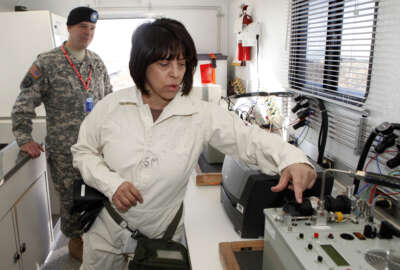
Army wants its business systems of the future to be intuitive to users
The service says the Enterprise Business Solutions – Convergence needs to be easy for soldiers and civilians to pick up.
The Army is in the early stages of converging five of its large, legacy business processing systems into one streamlined process for the service to use.
The hope is to save money and make these enterprise resource planning (ERP) systems more accessible through cloud access and better user experience.
The service is in the process of calling on industry for ideas on the best ways to accomplish this feat, and it’s asking companies for new and exciting ideas that will take the system to the next level.
“A lot of people will think this is a pure integration job,” Young Bang, Army principal deputy assistant secretary for acquisition, logistics and technology, said Tuesday at the Enterprise Business Solutions – Convergence (EBS-C) Industry Day. “There may be some of that, but a huge component of that is going to be around software development. We want companies to innovate, give us different solutions, give us software development in an agile manner. Don’t give us the traditional big bang approach. We want really innovative solutions across the board.”
Much like many of the military’s IT undertakings in the past few years, the Army wants EBS-C to be rooted in agile development, DevSevOps and to be easily translatable to troops using the program.
The Army’s Digital Transformation Strategy specifically calls out the convergence of EBS.
“The Army’s EBS should aim to provide the warfighter with the most modern capabilities available to execute sustainment or fiscal management operations, be interoperable with sustainment functions resident in current and future warfighting mission area systems,” the strategy states. “The Army will re-engineer its business processes to align with commercial best practices, threat mitigation best practices, and, where feasible, take advantage of commercial off-the-shelf software capabilities. The Army will also establish an open technical architecture and open application programming interfaces for integration and interoperability in order to minimize vendor lock in and retain flexibility to adopt newer technologies in future.”
The Army says industry will not be alone in creating this model. The service’s chief information officer, Raj Iyer, noted that the Army may offer up software licenses, DevSecOps tools and COTS programs that will be ready to go and approved for use.
One main motif that the Army is looking for in the development of EBS-C is intuitiveness. Bang, Iyer, Ross Guckert, the program executive officer for enterprise information systems, and Brig. Gen. Michael Lalor, executive director for EBS, all reinforced is that they want soldiers and civilians to be able to pick up the system quickly.
“Whatever we build has to be so intuitive, that you do not need any kind of new training or user manual to be able to go use the application, so set that as the bar for what you need to be looking at,” Iyer said.
Lalor added that the more intuitive the Army can make EBS-C, the faster it can implement, the more it saves on training and the quicker the services can integrate the program within its ranks.
“Very much the focus is still on the on the user experience and making sure that that’s as intuitive, as easy as possible,” he said. “However, we’re absolutely committed to making sure that our operators and teammates across the board are versed on the capabilities and the training required to execute whatever the specific platform or software that we actually utilize.”
Iyer told Federal News Network earlier this summer that he’s planning on spending $1.4 billion this year maintaining the five ERPs that EBS-C will replace, plus their 150 support systems.
“Our marquee effort in 2023 is going to be our implementation or initial prototyping for our new enterprise business systems convergence,” he said. “We’re trying to converge them into a single architecture or into a single system if we can. If we have one integrated capability, then, more importantly, the data that we can pass across that spectrum of operations for analytics. It is a massive, multi-year modernization effort. We fully expect that it will be as high as 10 years for us to get to that modernization effort. But the approach that we’re taking isn’t a big bang approach that we’ve typically used in the past. This is going to be more of an evolutionary modernization approach.”
The Army is planning on awarding multiple prototype contracts through other transaction authorities for EBS-C by early 2023. Those will run for a year to 18 months.
Copyright © 2024 Federal News Network. All rights reserved. This website is not intended for users located within the European Economic Area.
Scott Maucione is a defense reporter for Federal News Network and reports on human capital, workforce and the Defense Department at-large.
Follow @smaucioneWFED




